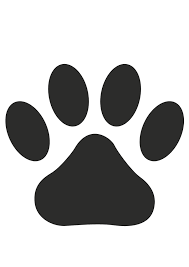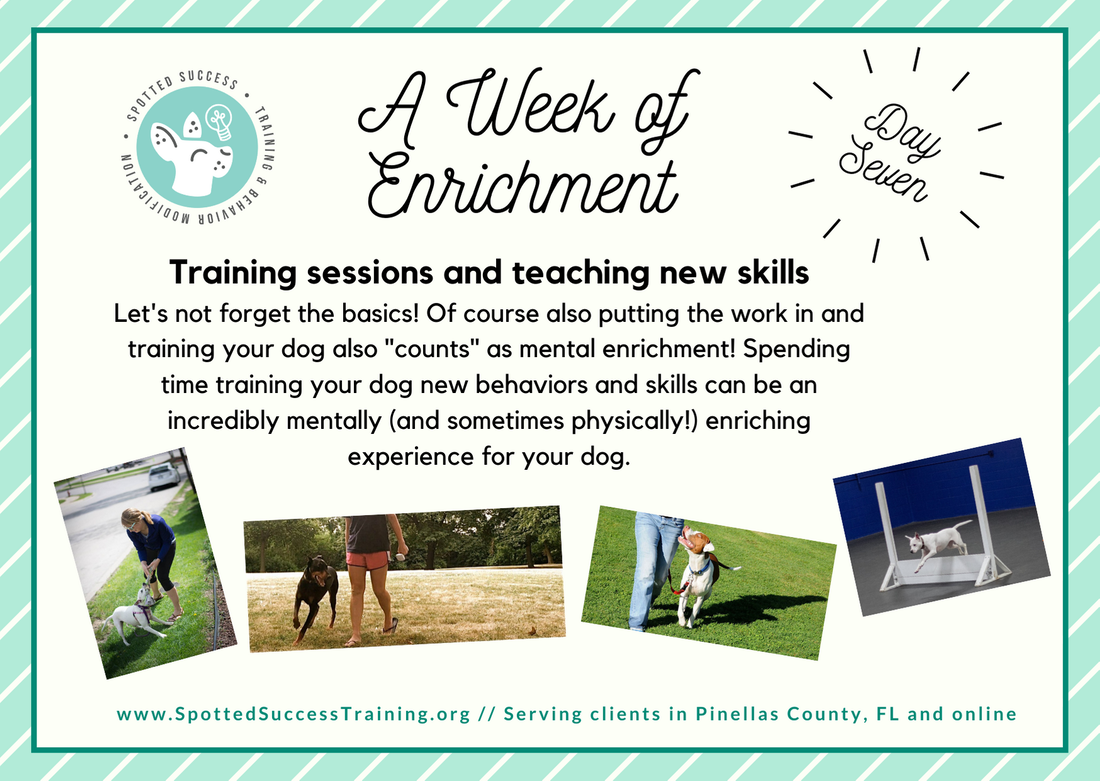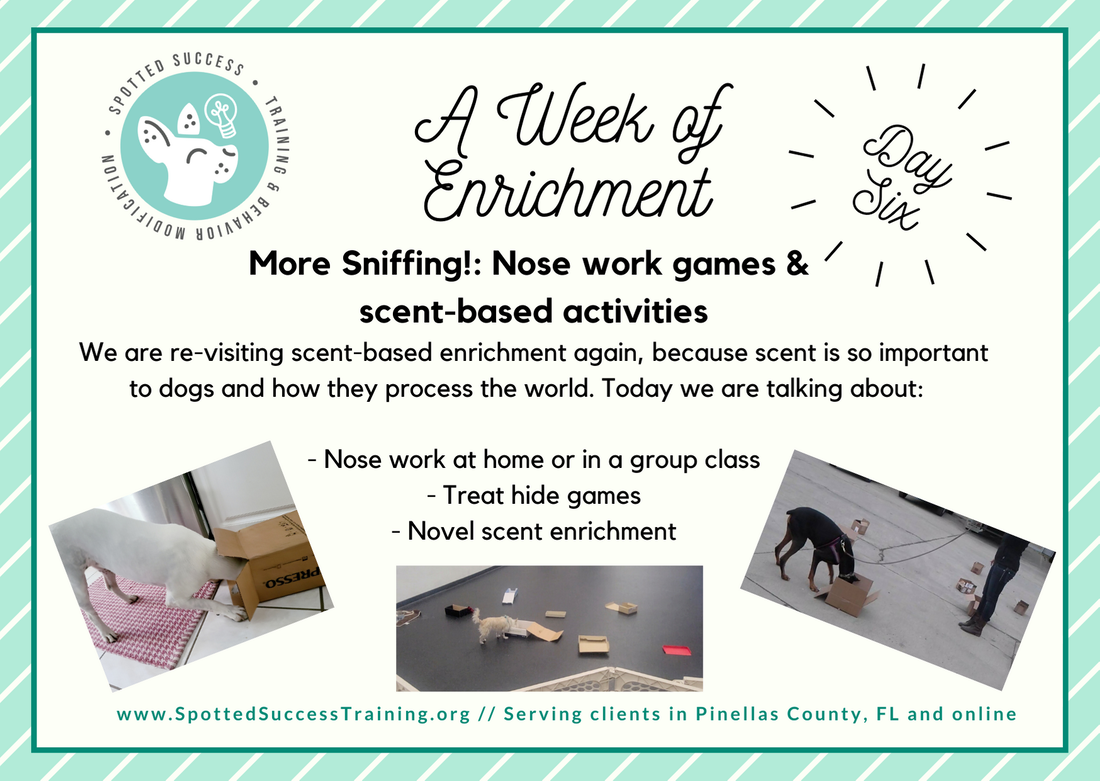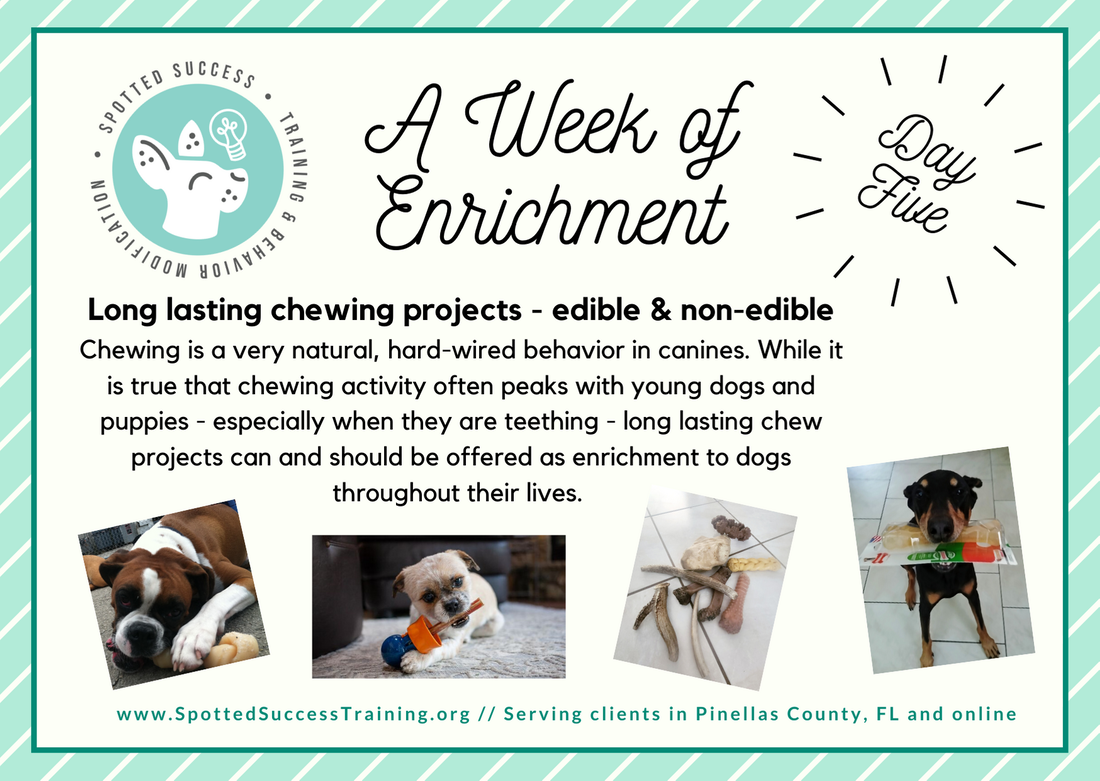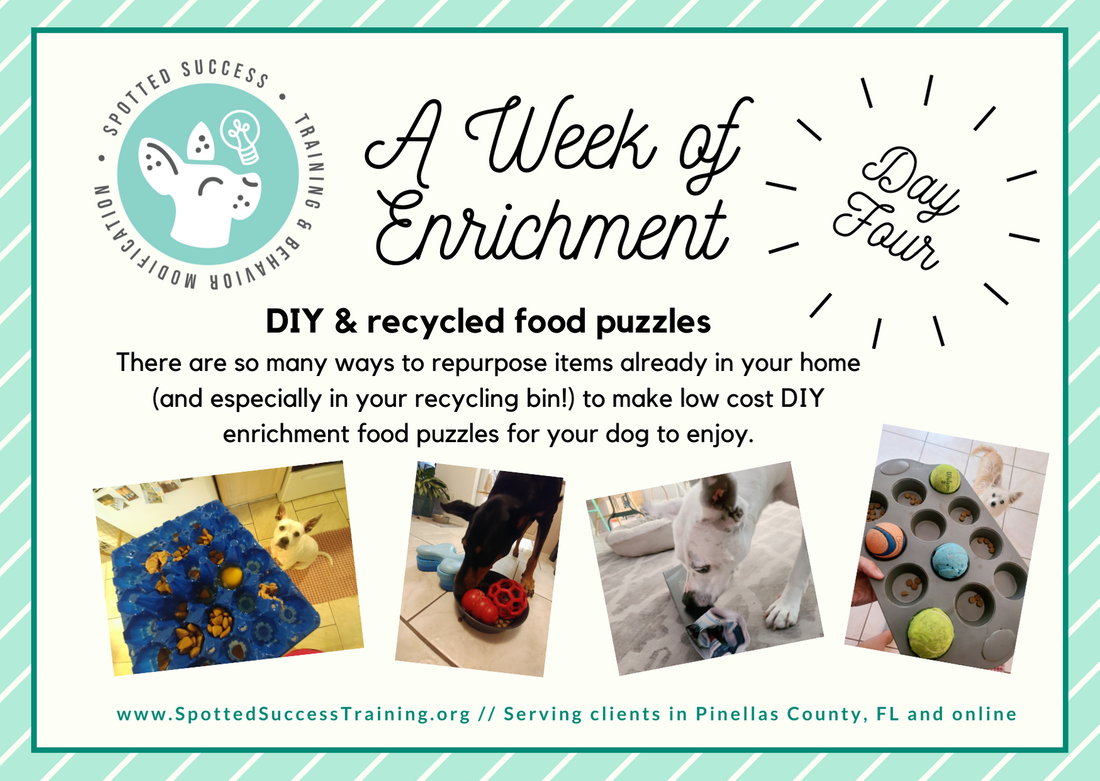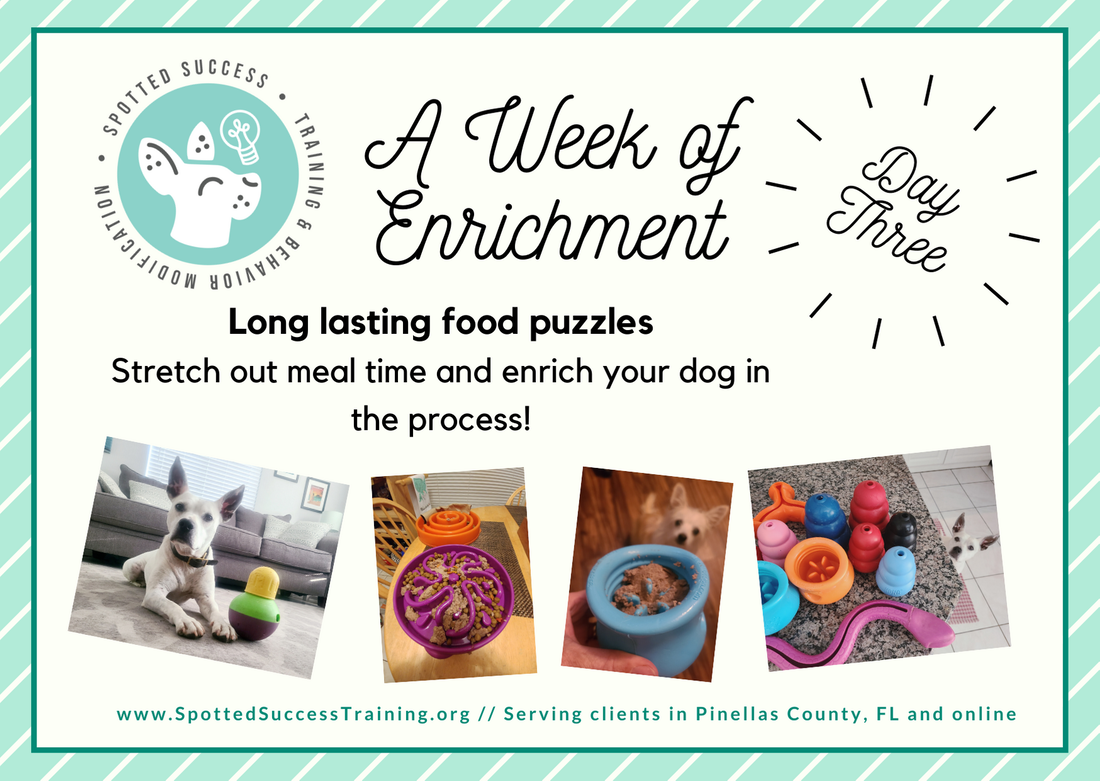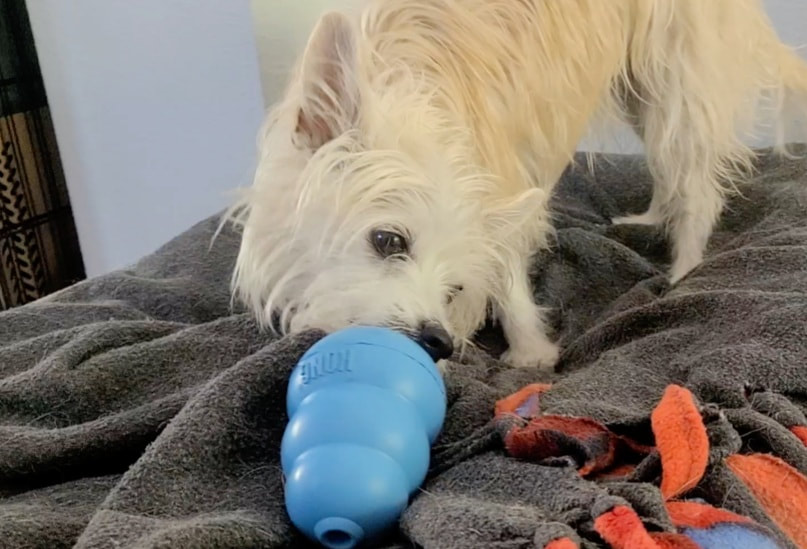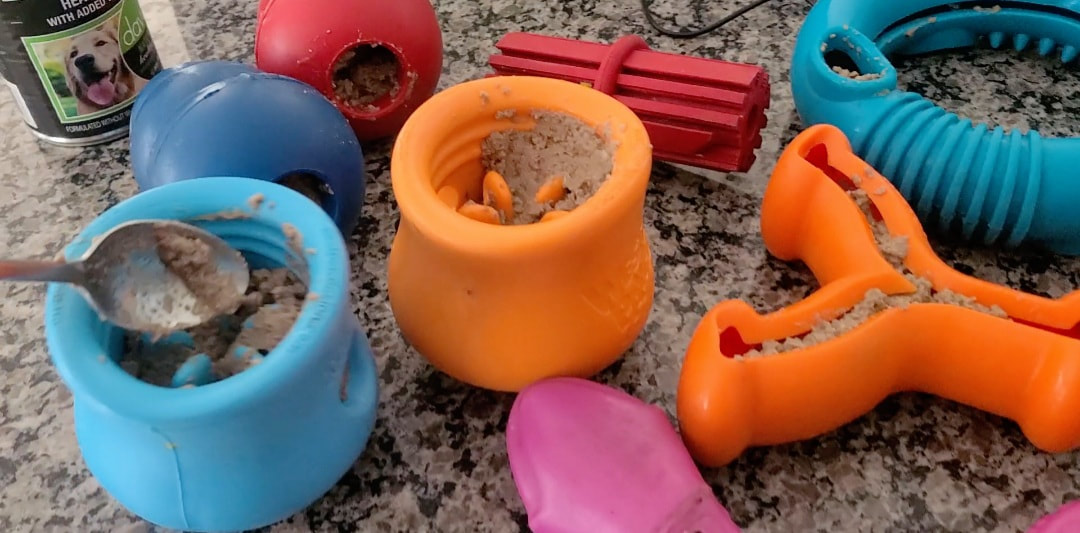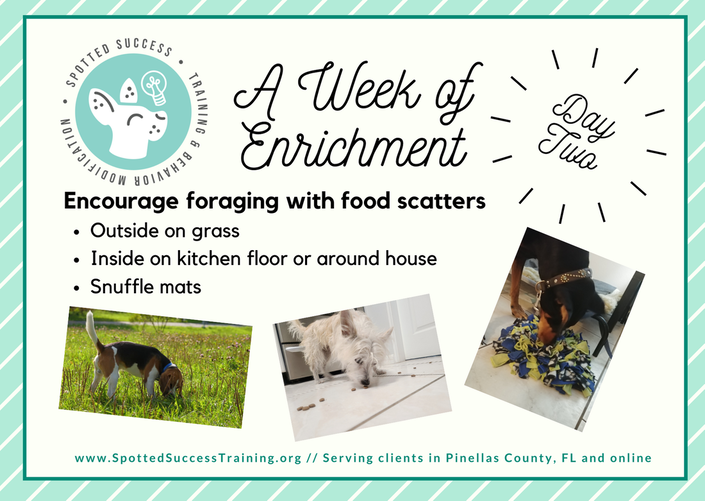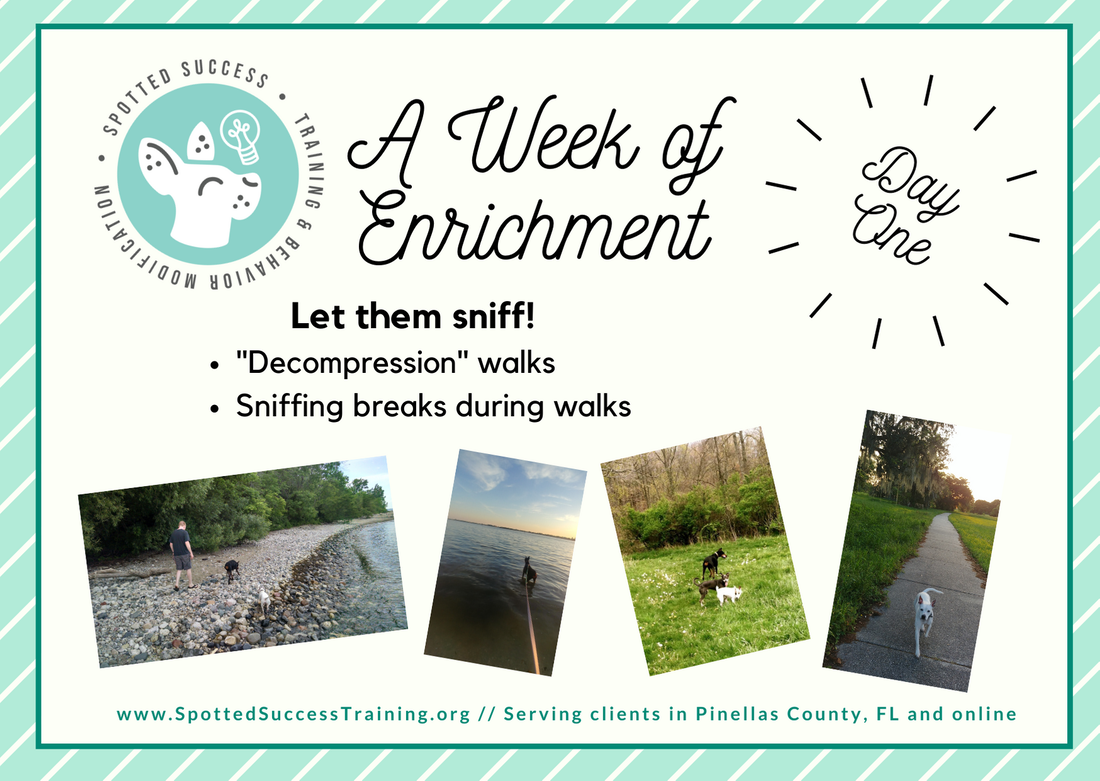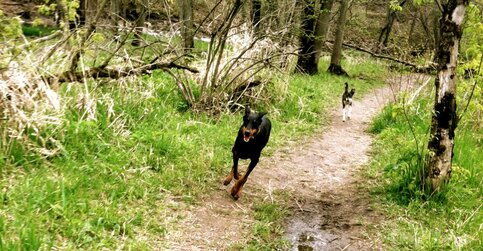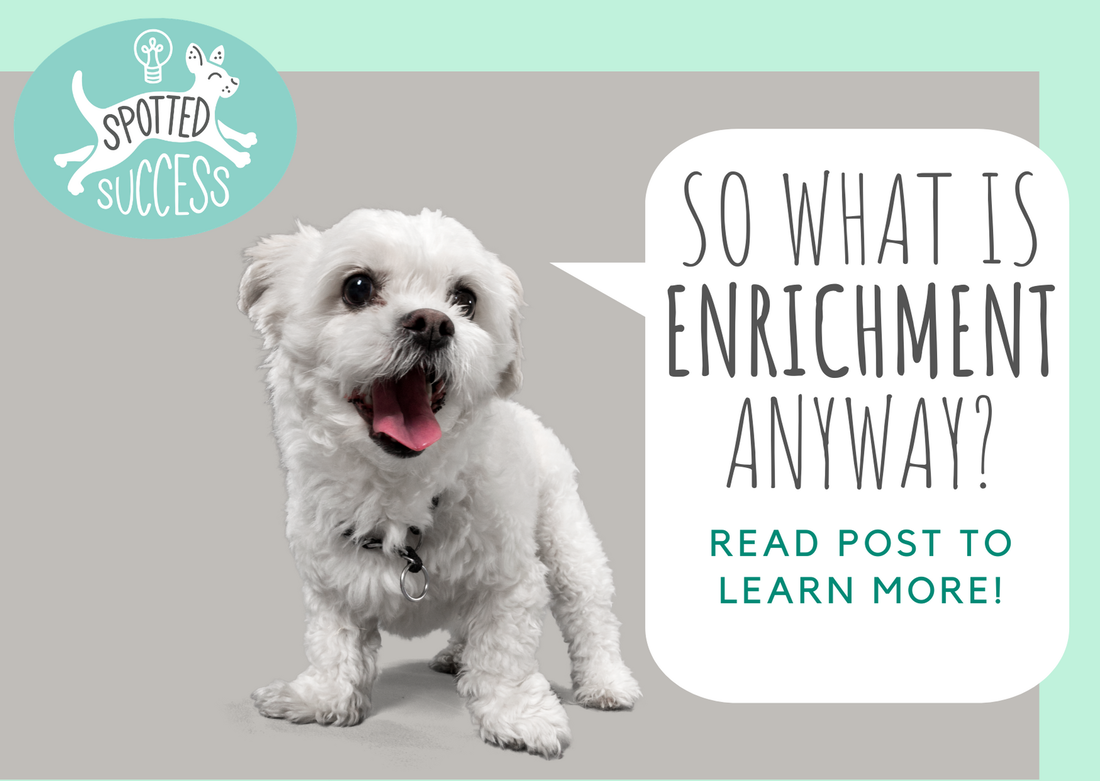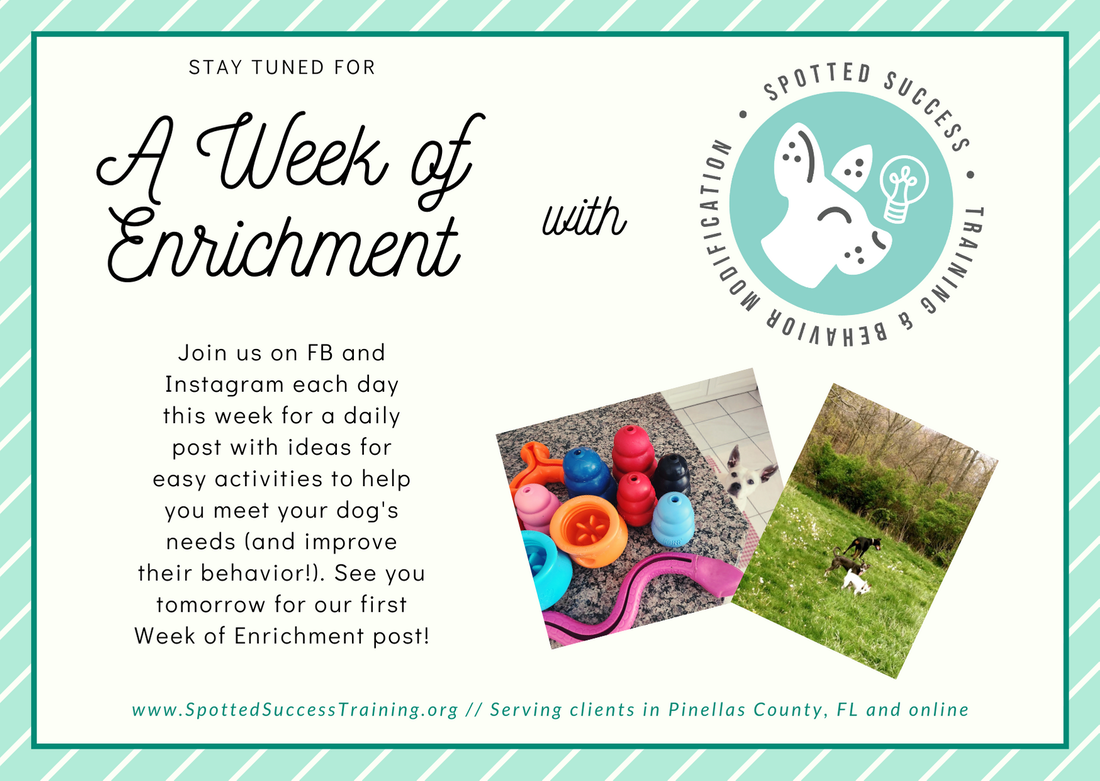|
Training Sessions and Teaching New Skills: Let's not forget the basics! Of course also putting the work in and actively training your dog also "counts" as mental enrichment! For DAY SEVEN - our final day in our Week of Enrichment series - we are talking about the enrichment benefits of actively working with and training your dog. All of the enrichment suggestions we have covered so far during this series have focused on different activities that allow and facilitate your dog exhibiting natural dog behavior in a variety of ways. All of these activities can be extremely beneficial in meeting your dog's behavioral needs over time, resulting in a calmer, more relaxed, and more fulfilled dog who is much less likely to exhibit undesirable behaviors. I never tire of seeing photos and videos of clients' dogs crashed out and sleeping soundly post-training session! In addition to all of those creative ways to "let your dog be a dog," actively spending time training your dog new behaviors and skills can be an incredibly mentally (and often physically!) enriching experience for your dog. With the various high energy dogs I have personally lived with, I can often take them for a long run, give them the opportunity to jog alongside by bike, and go for long hikes, and sometimes they still come home and seem to say "That was a fun warm-up, what's next?!" It is worth noting that intentionally shaping calm behavior in the house is a big component of teaching these high energy dogs to have an "off switch" (feel free to reach out if you need help teaching your dog this valuable life skill!). However, I have found time and time again with countless dogs that even a short training session focused on practicing or learning a new skill satisfies them and tires them out very consistently. Good training = good mental enrichment! After even a short training session, I often see even the highest energy dogs opting for a deep nap with restful REM sleep (legs twitching, dreaming of chasing squirrels anyone?!). With my personal dogs, I train and compete in sports with my dogs sports like Obedience and Agility, and I consistently find working on the precision skills these sports require (using motivational, positive reinforcement-based methods) provides a wonderful amount mental stimulation and enrichment. Even if dog sports aren't your thing, you can do living room and backyard training sessions and reap the same benefits. If you are looking for some inspiration on some fun, fancy, or practical behaviors to train your dog, I encourage you to check out this "Dog Tricks Tutorial Playlist" by trainer Emily Larlham from Dogmantics Dog Training on YouTube: https://www.youtube.com/watch?v=IQUerO0woqw&list=PLXtcKXk-QWogjBYMZAtA19Y5vc6AgnRAe Also consider working with a professional trainer or behavior consultant for in person (or virtual) training help, whether you need assistance working through a behavioral issue with your dog, or just want some guidance and inspiration to teach new behaviors and skills, bring out your dog's best potential, and have fun in the process. Spotted Success, LLC offers in person private training in Pinellas County, Florida, but I also offer virtual sessions available to anyone, anywhere with a dog. For more information on working with me, visit: https://www.spottedsuccesstraining.com/train-with-us.html If you need help finding a trainer locally, I encourage you to check out the following Search Listings as a starting point to find a certified professional near you: Certification Council for Professional Dog Trainers (CCPDT) Dog Trainer Directory: https://www.ccpdt.org/dog-owners/certified-dog-trainer-directory/ International Association of Applied Animal Behavior (IAABC) Behavior Consultant Search: https://iaabc.org/consultants Now pick something new to work on, and go train your dog! Happy Training! As always, feel free to reach out if you have any specific questions or want guidance on what might be appropriate for your individual dog. Thank you so much for joining us for our Week of Enrichment series! This was an enjoyable series to put together, and I hope you are ending with some motivation and inspiration to provide a variety of enrichment activities for your dog to meet their behavioral needs, reduce problematic behaviors, and improve your dog's (and your!) overall quality of life. Stay tuned and make sure to "Like" and follow Spotted Success on Facebook (Spotted Success, LLC) and on Instagram (@spottedsuccess) for more dog training and behavior content.
0 Comments
More Sniffing! Nose Work Games and Scent-Based Activities: On Day One of our Week of Enrichment series, we talked about how allowing sniffing breaks on neighborhood walks and going for regular off leash (or long line) decompression walks (with plenty of sniffing and exploring!) are both incredibly effective ways to provide adequate mental and physical enrichment for your dog. Here on Day Six we are re-visiting scent-based enrichment again, because scent is so important to dogs and how they process the world. Smelling stuff is one of the very best "being a dog" outlets that you can provide for your dog to help keep them enriched and less likely to exhibit undesirable behaviors. Remember, dogs possess up to 300 million olfactory receptors in their noses, compared to just about six million in ours. Today we will be talking about nose work games and other scent-based enrichment activities, all of which can be extremely enriching and satisfying (read: tiring!) activities for your dog. Nose Work Games: "Nose work" refers to activities where you train your dog to sniff, search, and seek out a target odor. The beautiful thing about nose work activities is that once you introduce the activity, it is a skill set (sniffing!) that is innate and comes naturally to our dogs. Nose work is equally enriching and beneficial for big dogs and small dogs, young dogs and old dogs, extremely active dogs and more sedentary dogs, and even dogs with other physical limitations. Smelling truly is universal when it comes to dogs! You easily can start some enriching nose work activities with your dog at home by simply teaching them to sniff and seek out hidden treats in a variety of ways. For dogs brand new to these activities, you want to start easy and build up the challenge over time. Your first session might involve letting your dog watch you place a treat in a low-sided cardboard box, then allowing them to investigate, sniff out, and eat the treat. You gradually increase the difficulty by adding distance or more boxes, and by not allowing your dog to see where the treat was placed, and instead releasing them in the search area to sniff out and find the prize. The sky really is the limit when creating nose work puzzles with treats for your dog in the house and in the yard. Increase difficulty slowly so that your dog can be successful every step of the way, but gradually incorporate challenges like more boxes to search in or treats hidden under a towel or blanket. Some dogs really enjoy being released to sniff out a food dish or a food puzzle toy hidden in a different room of the house for meal time. Get creative and the scent based enrichment opportunities are endless! While hiding treats and food for scent based enrichment games works very well for many dogs, it is also possible to take the activity of nose work one step further, and actually train your dog to seek out specific scents and target odors (for example, birch odor, clove odor, etc). The odor is often dripped on a cotton swap or cotton q-tip, which is then hidden in a search area. This adds to the challenge and enrichment of the activity for your dog - they learn to detect and pursue different odors which are then paired with a reward the dog enjoys. I have participated in some formal nose work training and titling with my own personal dogs and foster dogs, and I quite often incorporate nose work games into behavior modification plans when working with private clients. Encouraging dogs to sniff and explore their environment through smell can have a remarkable impact on their behavior and encourage positive behavior change in a variety of ways. That being said, nose work is actually a structured "sport" for dogs (similar to activities like agility and obedience, for example), designed to mimic professional detection dog tasks. You can earn titles in nose work through organizations such as the National Association of Canine Scent Work (https://www.nacsw.net) or the American Kennel Club (AKC) scent work program (https://www.akc.org/sports/akc-scent-work). To dive in and get more involved in the formal sport of nose work, I highly recommend enrolling in a class with a Certified Nose Work Instructor (CNWI) or someone experienced in the sport. Taking a class doesn't mean you have to enter competitions compete for titles - many, many active pet dog owners take classes for a mutually enjoyable and enriching activity to participate in with their dogs, without any intentions of competing. If you are local to the Pinellas area that Spotted Success serves, I have the following recommendations for formal nose work classes and activities:
Other Scent Enrichment for Pet Dogs- All Sorts of Novel Scents! Did you know that you can actually buy bottled "animal scents" like duck, pheasant, quail, or squirrel? Used as scent-based enrichment, these can also be very mentally stimulating and enriching for dogs. If you purchase these scents and dilute them in a spray bottle, you can spray them in different spots in your yard to add interest and encourage sniffing and exploring instead of barking, fence fighting, digging, or other undesirable "yard" behaviors. Hunting supply stores and suppliers are a great resource for finding and purchasing novel animal scents to use as enrichment for your dog: https://www.dickssportinggoods.com/f/hunting-scents-lures Please note: I do not advocate leaving dogs alone or unattended in the yard, and there are a lot of behavior modification strategies that can be implemented to steer your dog away from exhibiting undesirable behavior in the yard. Adding novel scent enrichment in the yard won't necessarily "fix" already established behavior patterns; scent enrichment aims at preventing issues by meeting your dog's behavioral needs and preventing problem behaviors from developing. If you need help altering your dog's undesirable behavior in the yard, upping the enrichment available to them is a great first step, but I also urge you to reach out for help from an experienced trainer or behavior consultant to work through a behavior modification plan. You can also spray the novel animal scents on some of your DIY food puzzles and enrichment toys (see Days Two and Three of our Week of Enrichment posts) for added interest and mental stimulation. For example, you could stuff a recycled cardboard paper towel roll with food and newspaper as a DIY food puzzle, and then spray an animal scent on it for a food and shredding/chewing and scent-based enrichment activity. Keep in mind, scent is enriching in general to dogs - some scent can stimulate, and some scent can calm. If you are using the novel animal scents described above, you are likely stimulating your dog's senses, but the long term effect will actually be calmer behavior from your dog during down time (after having adequate mental stimulation through these active enrichment sessions). For scent enrichment activities with pet dogs, I generally like using the novel animal scents because I find that they are innately intriguing and enriching. Many dog trainers, behavior departments within animal shelters, and zoo keepers and trainers working with a wide variety of species also have success using other novel scents such as lavender, vanilla, chamomile, almond, coconut, and peppermint scents. These scents can also be diluted in a spray bottle and sprayed on plastic toys, bedding, or towels. You could even sprinkle dried spices like cinnamon, cloves, and ginger on the floor, on the grass outside, or on blankets for your dog to investigate. As we have mentioned many times throughout our Week of Enrichment, every dog (every animal!) is an individual. A big part of providing varied enrichment activities for your dog involves some trial and error, figuring out which activities result in great mental stimulation (and positive behavior change) for your individual dog. And so, Happy Sniffing! Give some nose work and scent based enrichment activities a try with your dog and feel free to reach out if you have any specific questions or want guidance on what might be appropriate for your individual dog. And join us tomorrow for DAY SEVEN, our final day in our Week of Enrichment series! Long Lasting Chew Projects: Chewing is a very natural, hard-wired behavior in canines. While it is true that chewing activity often peaks with young dogs and puppies - especially when they are teething - long lasting chew projects can and should be offered as enrichment to dogs throughout their lives. Every dog is an individual, and some adult dogs have a stronger desire than others to work on chewing projects, but if you find the items your dog enjoys for chewing, it is a satisfying enrichment opportunity that helps meet their behavioral needs throughout their lives. Remember, consistently finding ways to meet your dog's behavioral needs and give them opportunities to "act like a dog" makes for a calmer, more relaxed, and more fulfilled dog who is much less likely to exhibit undesirable behaviors. PLEASE NOTE: The chew item suggestions listed below are all personal recommendations based on what I have used for my own dogs and other clients' dogs with great success, and at the recommendation and approval of my own veterinarian. You should never feed cooked bones to your dog. I have had great experiences with giving weight-bearing, large, raw bones as recreational chews. I have also had great experiences using the harder, more durable chews listed below to allow my dogs to exhibit natural dog behavior and hard chewing. I personally feel they can be a good form of enrichment for many dogs, and they allow dogs to exhibit species appropriate behavior on the appropriate item (i.e. satisfying their urge to chew with the bone, not by chewing your belongings). You will, however, hear differing opinions on providing hard chewing items, and there is always an inherent risk of a dog injuring or chipping a tooth. For me, the behavioral benefits of providing long-lasting chew projects for dogs outweighs the risk, and as such I choose chewing items carefully and supervise closely when appropriate. That being said, I am not a veterinarian, and I have encountered differing opinions from veterinarians on the merits and safety of giving raw marrow and knuckle bones and other hard recreational chews. Please speak to your veterinarian if you have any questions or concerns. Long Lasting Inedible Chewing Options: In addition to the feeder toys we discussed in other Week of Enrichment posts, and in addition to the edible chew options provided below, I encourage you to also provide your dog with plenty of his own durable and inedible chew toys. Pay attention to the types of toys that keep him chewing for long periods of time (ideally really getting into the chew using his back teeth) and continue to offer those on a regular basis - around the house, in crates, in the yard, etc. "But my dog has SO many chew toys and he ignores them!" I hear so often from people who tell me they have countless chew toys for their dog, but the dog "ignores them all." Here are a few tips and tricks: It’s ideal to introduce something new or rotate your dog’s chew toys every couple of days so that he doesn’t get bored with the same old toys. So for example, in my house we probably have a dozen various durable/ non-edible chew toy items. I typically only have four or so of them out and available to the dogs at any given time; the others are put away in a closet of out of reach of the dogs, and I bring them out and rotate the toys every few days. If you are using Nylabone chew toys, you can soak the Nylabone in beef or chicken broth for twenty minutes and then give it to your dog. Soaking it in the broth adds extra smell, flavor, and interest, and will usually peak the dog's interest enough to get them chewing. Often times they will continue chewing even after the smell and flavor fades because they become invested in the chew project. You can also foster some interest in chew toy that has gone unchewed for some time by doing a toy swap and allowing a friend or family member's dog to borrow the chew toy for a few days, then give it back to your dog. The toy will be "pre-chewed" by the other dog, which means new grooves, ridges, and smells which can then actually make the toy a lot more appealing to your own dog. Here are some of my favorite durable non-edible chew toy options for dogs who love to chew:
Long(ish) Lasting Edible Chewing Options:
In summary, in my behavior work with clients and with my own dogs, routinely giving dogs long lasting chewing toys and projects has a tremendous effect on their overall behavioral health. With proper outlets for natural behaviors like hard chewing, I see a significant reduction in destructive and anxiety-related behaviors. Happy chewing! Stop back tomorrow for Day Six of our Week of Enrichment! DIY & Recycled Food Puzzles:
In yesterday's Week of Enrichment post about store bought feeder and puzzles toys, I mentioned that there are SO many different food enrichment and puzzle toys available for dogs - the pet supply industry is saturated with them, and sometimes the options can be overwhelming. The good news: you don't have to go out and buy every puzzle toy available in order to effectively provide daily enrichment and food puzzle opportunities for your dog! There are so many ways to repurpose items already in your home (and especially in your recycling bin!) to make low cost DIY enrichment food puzzles for your dog to enjoy. Here are a few ideas to get you started:
Things to Note:
Now go make a puzzle for your dog, and check back tomorrow for Day Five of our Week of Enrichment! Long Lasting Food Puzzles:
Dogs are a hunter-scavengers at their roots; they want to search, forage, and eviscerate! We want them to do this with "appropriate" items - not our throw pillows! The easiest way to provide this type of enrichment is by utilizing our dogs’ daily calorie requirements, and having them "work for their food" in mentally enriching ways. Here are some ideas for feeding your dog in a smarter way. All of the "feeder toys" below can be stuffed with combination of kibble and wet dog food for one of your dog's meals (or freeze dried or pre-prepared raw food if that is what you feed!). Freeze each of these items after stuffing for a longer lasting, more satisfying puzzle or meal:
Things to Note:
In summary, in my behavior work with clients and with my own dogs, simply getting rid of bowls for at least one meal a day, and giving dogs long lasting food enrichment projects has a tremendous effect on the overall behavioral health of the dogs in question. A reduction in destructive and anxiety-related behaviors happens in my own dogs and is reported by my clients. Try it, and tell me what differences you see! We will see you tomorrow for Day Four of our Week of Enrichment, where we will be talking about some cheap and easy DIY options for enrichment feeder toys. Food Scatters Treat or kibble scatters are my favorite "lazy" enrichment activity. This enrichment activity involves just what it sounds like - I literally take a handful of small treats or kibble and toss/ scatter it all over an area, then let the dog(s) get busy foraging and searching for the pieces. You might do this across the linoleum floor in your kitchen, in various rooms of the house (forming a "trail of treasure" for your dog to seek out and find), or (my personal favorite) across the grass of the backyard. I jokingly call this "lazy" enrichment, but in actuality it provides a fulfilling and time consuming activity for the dog. It is a technique commonly called "scatter feeding" in the animal training world, but again this practice is not always as common in the pet dog world; I am arguing that it really should be! If you spend time around dog trainers, you may hear the phrase "Ditch the Dish!" used when talking about using food to give your dog more enrichment opportunities in day to day life. "Ditch the Dish" refers to there being many different ways to use the calories/ food that our dogs are going to receive anyway in the course of the day to stimulate their brains and bodies. Treat or kibble scatters are just one of many examples of food-based enrichment activities. Dogs are by nature foragers and scavengers. "Working" to get their food by smelling, seeking, and foraging is a very natural, "doggy" thing to do that helps satisfy them on a very basic level. After all, mother nature doesn't provide neat meals in stainless steel bowls! In addition to the enrichment and mental stimulation that food scatters can provide, this can also be a great technique to slow dogs down who eat (inhale!) their food too quickly from a standard bowl. I have been known to chuck a large handful of kibble (my dog's breakfast) across the kitchen floor before leaving the house to run errands, and foraging for dinner (a tossed cup of kibble spread out across the grass) in the backyard is a favorite activity for the dogs in my home. I realize that if you have never heard of this practice before it may sound strange at first, but give it a try and I promise you will reap the benefits from a more satisfied dog. Things to Note:
Snuffle Mats: "Snuffle mats:" another term becoming quite common in the dog training world, but still sometimes less known in the pet world. If you haven't heard of a snuffle mat before, it is an enrichment toy for dogs typically made with a square of rubber backing that has tons of thick fleece (or sometimes other fabric) strips ties to it. The end result looks kind of like the cross section of a really long shag carpet made from fleece strips. You scatter treats or kibble on top of and in between the fleece strips, and the dog uses their nose and muzzle to "snuffle" in the fleece to forage for and find all of the food pieces. It is a food scatter as described above, but with an added challenge! Some people more crafty (and patient!) than myself make snuffle mats themselves for pretty low cost, but you should also be able to easily find one to purchase if you search for "snuffle mat" on Google or Etsy. As with any new toy, it is important to supervise your dog closely when they are using the snuffle mat to make sure they aren't chewing on/ destroying/ consuming the fleece pieces or mat itself. This is definitely an item I put down when my dogs are actively using it with food scattered in the mat, then I pick it up and put it away and out of the dogs' reach after use! I have also used snuffle mats as a great tool for keeping a dog occupied and engaged while in the waiting room at the vet clinic or while waiting in between exercises at an in person dog training class or seminar. Snuffle mats are similar to food scatters and are a great way to add some extra challenge and novelty to the activity of foraging and searching for the pieces of food. In summary, as with other enrichment activities, food scatters and snuffle mats can be another way to help fulfill your dog's behavioral needs more fully, which will in turn leave you with a dog who is satisfied, more relaxed, and less likely to practice undesirable behaviors. Now go scatter some food for your dog to find, and stop back tomorrow for "Day Three" in our Week of Enrichment! 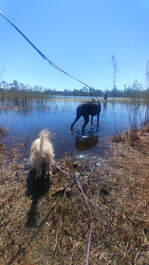 Did you know that dogs possess up to 300 million olfactory receptors in their noses, compared to just about six million in ours? Keeping this in mind might help make sense of why it seems like your dog is so "distracted" by wanting to smell anything and everything in a new environment. We as humans might scan the horizon and reach out to touch things; dogs are much busier soaking in as much information as possible through their ultra-sensitive noses. The good news for us: this means allowing our dogs to sniff and take in scents in new environments and while out on walks is an extremely enriching and satisfying (read: tiring!) activity for your dog. "Decompression Walks:" A "decompression walk" is a fairly commonplace term in the dog training community (I first heard the term coined by Sarah Stremming of The Cognitive Canine), but it is less prevalent in the pet dog world. A decompression walk means a walk where you go to a natural location (think wooded trail, beach front, grassy fields, etc) and either allow your dog off leash time, or time walking with you wearing a long line where they are free to move around naturally - smelling, running, exploring, and just generally "being a dog." These types of walks are at least 75% of the exercise walks my personal dogs and foster dogs get. Decompression walks fulfill their need to "dog" in a way very few other things can, and it results in dogs who are more relaxed and satiated because their most basic needs have been met; in other words, with regular decompression walks incorporated into their week, the dogs are more relaxed, willing to settle and sleep in the house while I get other things done, and are less likely to display "nuisance" or undesirable behaviors. Things to Note: 1.) You DO need to choose your locations for decompression walks carefully, and you DO need to have a reliable recall (dog comes running to you when called) in order to safely practice off leash decompression time with your dog. The process of teaching this as a reliable skill is more complex than I can delve into in a social media post, but if you need help and guidance in this area, consider reaching out to a professional trainer. The right trainer will be able to help you build coming back to you as a rock solid skill for your dog. Having a reliable off leash recall (and using it carefully and with common sense) can open the door to so many adventures and opportunities for you and your dog! 2.) There are definitely circumstances (for example: leash laws, concerns about encountering wildlife, a dog who hasn't yet achieved a reliable recall, etc) where it may make sense to use a long line while going for a decompression walk instead of allowing full off leash freedom. And that is okay! If I am using a long line for a decompression walk, I prefer to use a 10 -15' line made of Biothane material. If you are not familiar with Biothane, it is a polyester webbing with a TPU or PVC coating that makes it more durable, waterproof, and easy to clean. It is becoming quite popular as a material for dog collars, leashes, and long lines, and you should be able to easily find one to purchase if you search for "Biothane long line" on Google or Etsy. 3.) If you are having trouble finding or thinking of locations near you to give decompression walks a try with your dog, I have the following suggestions:
I have lived in urban environments in several different major cities with my dogs over the past thirteen years, and with a little creativity we have always been able to come up with at least several different locations for great decompression walks within reasonable driving distance. If you live in the Saint Petersburg/ Pinellas County area that Spotted Success serves, feel free to reach out for some recommendations on my favorite local "decompression walk locations." Sniffing on Neighborhood Walks: I mentioned above that roughly 75% of my dogs' are the "decompression" style of walks described above - this is on purpose and by design! Unfortunately, your typical urban or suburban neighborhood can really encourage and actually teach your dog to be on edge and reactive towards other dogs. Think about it - on your typical neighborhood walk, how many times do you pass a house with a dog barking at the window, a yard with a dog barking at the fence, or another dog being walked on leash who is barking/pulling/ whining/ scrambling in the general direction of you and your dog? Depending on the neighborhood, sometimes it feels like walking through a "not so fun house" (i.e. you never know what is going to jump out at you next!). Of course it is possible (and highly recommended!) to teach your dog life skills to navigate neighborhood walks successfully (loose leash walking, checking in with handler, responsive to basic cues, ability to walk past distractions calmly). However, if being barked at every 50 feet becomes the "norm" for your dog during walks and they don't have other opportunities to decompress in more natural way (as described above), you may find yourself dealing with reactive, fearful, overly-exuberant, or even aggressive behavior displays from your dog during neighborhood leash walks. That being said, the reality is that in day-to-day life, many of us have to "settle" for a more urban neighborhood walk on days where we don't have the time or resources to get our dogs out for a longer or more fulfilling decompression-style walk. The good news is that you can still incorporate allowing your dog to sniff, explore, and use their nose during these neighborhood walks to maximize the mental enrichment they receive during the walk (read: help meet your dog's needs to tire them out!). On neighborhood walks with my own dogs and with clients' dogs, I prefer to differentiate between two cues for the dogs: 1.) A "Let's Walk" cue This means we are focused on loose leash walking with the dog checking in with the handler and without impulsively pulling and lunging towards interesting smells and distractions. I teach and use this cue when walking from "point A to point B" on sidewalk paths or similar. 2.) A "Go Sniff" cue Used often throughout the walk, this cue tells the dog they are able to go to the end of their leash and sniff/ explore a tree/ patch of grass/ bush/etc to their heart's content. The process of teaching these cues ("Let's Walk" versus "Go Sniff") reliably again falls a bit outside the scope of a social media post, but taught well, these skills can really make walks with your dog enjoyable, relaxing, and fulfilling for both you and your dog. Again, if you need help in this area with your own dog, feel free to reach out if you need guidance on how to find a trainer or behavior consultant in your area. In conclusion - let them sniff! I strongly encourage you to incorporate decompression-style walks and sniff breaks during neighborhood walks into your dog's regular exercise routine. Consistently implemented, doing so will help fulfill your dog's behavioral needs more fully, which will in turn leave you with a dog who is satisfied, more relaxed, and less likely to practice undesirable behaviors (the goal of ALL the different types of enrichment we provide for our dogs). I'll see you on the trails! Welcome to Spotted Success's Week of Enrichment!
For those who may be unfamiliar with the term, "enrichment" just means giving your dog ample mental stimulation, physical exercise, and the opportunity to do fulfilling "normal stuff for dogs." Why is this so important? It is important that we meet our dogs behavioral needs not only because it is the ethical thing to do, but also because it makes for a calmer, more relaxed, and more fulfilled dog who is much less likely to exhibit undesirable behaviors. If your dog's behavioral needs are not being met, trying to implement a training or behavior modification plan is kind of like using a tablespoon to flick water out of a sinking boat. There are MANY more than seven ways to enrich your dog physically and mentally, but the focus of this week will be to highlight one suggestion each day for seven days. We hope you will join us and come away with some inspiration and ideas for improving your dog's quality of life, AND their behavior! |
